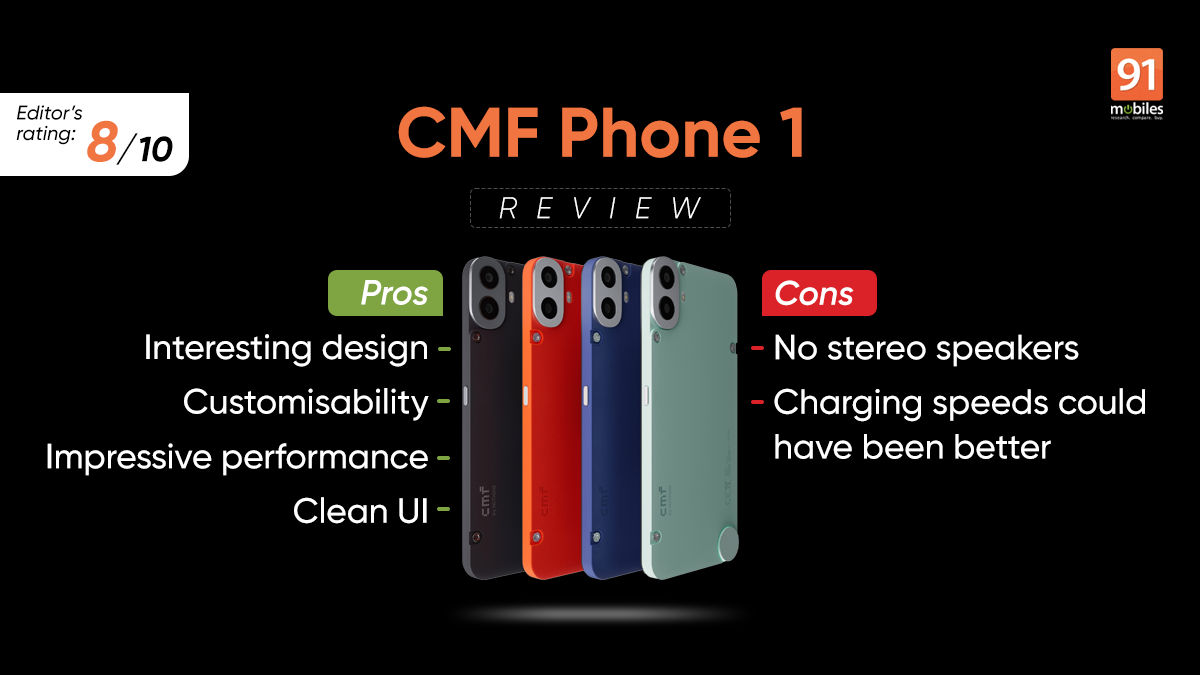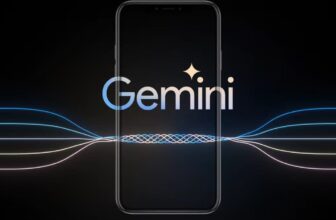
Nothing’s sub-brand CMF (short for Colour Material Finish) has forayed into the Indian smartphone segment with its first offering in the form of the CMF Phone 1. The handset targets budget-conscious buyers, and akin to its parent company’s approach, incorporates a design-first strategy. The CMF Phone 1 comes with interesting design choices that spark interest. Is that all the smartphone has to offer, or is there more to it than meets the eye? Read this CMF Phone 1 review to find out.
Verdict
The CMF Phone 1 is competitively priced in India, making it a compelling choice for those who enjoy experimenting with smartphone aesthetics. In addition to interesting design features, the handset offers reliable performance and the cleanest user interface in its segment. Furthermore, the phone’s battery is optimised to last a full day, depending on your usage, and the viewing experience it’s able to provide is good too. The handset would have been an easy recommendation if it had not been for the cameras and durability.
Design and display

Despite missing out on its parent brand’s signature Glyph Interface, the CMF Phone 1 features a unique and creative design. Though not entirely new, the design deserves recognition. The CMF Phone 1 comes with interchangeable back panels, reminiscent of the first-gen Moto G-series. Unlike Motorola’s offering, however, the back panel of the CMF Phone 1 is firmly secured with screws, a SIM ejector tray, and a rotating wheel screw. Located in the bottom right corner, the wheel can be removed to access a screw hole for attaching accessories like a kickstand for vertical or horizontal viewing, a card holder, or a lanyard. These accessories are sold separately for Rs 799 each. The panels, priced at Rs 1,499 each, come in three shades: Orange, Light Green, and Blue. Notably, the Blue and Orange panels have a vegan leather finish at the back and are 1mm thicker than the regular panels. The company could launch more such accessories in the future. Moreover, third-party brands could also launch their accessories that fit into the same screw hole.
| CMF Phone 1 | OnePlus Nord CE4 Lite | Realme P1 | |
| Thickness | 8mm/ 9mm (standard/ vegan leather) | 8.1mm | 7.97mm |
| Weight | 197g/ 202g (standard/ vegan leather) | 191g | 188g |
| IP rating | IP52 | IP54 | IP54 |
Despite its stylish appearance, the panels might not protect the screen from accidental drops like a case would, and finding a case for the device might be challenging at least initially. Additionally, the handset comes with an IP52 rating, which is not on par with the competition and only offers protection against minor splashes. Nevertheless, the plastic build of the phone feels solid, and it doesn’t creak or crack under pressure. The phone also looks quite sleek for its price, with flat edges that make the device comfortable to wield. The handset is relatively lightweight, measuring 197 grams (202g for vegan leather), for prolonged usage without giving a wrist work.
The rear cameras are arranged in a pill-shaped module in the top left corner, and it stands out with its silver accent, which is common across colour options. We received the black variant of the Phone 1 for review which looks quite elegant and has a matte finish which keeps fingerprints and smudges at bay. The bottom edge of the phone features a USB Type-C port for charging and data transfer, along with a speaker grill and a SIM ejector tray. The volume rocker and power button are on the phone’s left and right spine, respectively, and provide a very tactile feel. For security, the phone is equipped with an in-display fingerprint scanner, which unlocks the device in a jiffy.
| CMF Phone 1 | OnePlus Nord CE4 Lite | Realme P1 | |
| Screen size | 6.67-inch | 6.67-inch | 6.67-inch |
| Peak brightness | 2000 nits | 2100 nits | 2000 nits |
Up front, the CMF Phone 1 sports a 6.67-inch Super AMOLED LTPS display with up to 120Hz refresh rate, 2,000 nits peak brightness, and FHD+ (1,080 x 2,400p) resolution. It is an 8-bit colour panel that bears a centred punch-hole setup for the selfie camera. The display quality is typical of what you get in the price range. The outdoor visibility is decent, if not impressive, making media consumption slightly difficult under direct sunlight. Colour calibration is somewhat boosted but remains vibrant, with a high contrast ratio and deep blacks.


The 120Hz refresh rate works well across UI and supported apps, and the handset is Widevine L1 certified, ensuring HD streaming from Netflix and other OTT platforms. The Phone 1 bezels, although slim, are relatively thicker than its competitors. Additionally, while the mono bottom-firing speaker is loud, it lacks the crispness of the stereo speaker setup.
Cameras


The CMF Phone 1 boasts a dual rear camera setup, comprising a 50MP primary sensor and a portrait sensor with an f/1.8 aperture lens. For selfies and video calling, the phone is equipped with a 16MP shooter in the punch-hole setup. This is a standard camera setup expected from the smartphones within the segment, with a few exceptions such as the Redmi Note 13, which includes an 8MP ultra-wide lens. Be that as it may, the CMF Phone 1 impresses with its camera performance in well-lit environments. However, the post-processing time to output the end result could be frustratingly long.
Here’s how good the smartphone’s cameras are against its close rivals, the Realme P1, Redmi Note 13, and OnePlus Nord CE4 Lite across various lighting conditions:
Daylight
Portrait
Selfie
For selfies as well, the Realme P1 seems to be doing a better job. The handset captures images with superior facial details and near-accurate skin tones. The CMF Phone 1, in contrast, shoots a slightly brighter selfie with warmer skin tones and sub-par detailing.
Lowlight
Neither CMF Phone 1 nor Realme P1 particularly stand out in dimly-lit environments. The CMF Phone 1 handles light flare relatively well, whereas the Realme P1 manages the sharpness better. However, even with night mode, the handsets fail to produce images likeable details and minimum noise level.
Performance and software
| CMF Phone 1 (Dimensity 7300) | iQOO Z9 (Dimensity 7200) | Redmi Note 13 (Dimensity 6080) | |
| AnTuTu | 6,42,187 | 7,28,534 | 4,53,830 |
| Geekbench single-core | 1,015 | 1,190 | 737 |
| Geekbench multi-core | 2,867 | 2,681 | 1,905 |
The MediaTek Dimensity 7300 handles the performance bit for the CMF Phone 1. It is a new mid-range chipset with a 4nm manufacturing process and octa-cores clocked at up to 2.5GHz. This is complemented by 6GB RAM + 128GB UFS 2.2 storage and 8GB RAM + 128GB UFS 2.2 storage configurations. The RAM is expandable virtually up to 16GB, and the storage can be increased up to 2TB using a compatible microSD card. The handset posts decent scores on synthetic benchmark tests, but it couldn’t beat the Dimensity 7200’s AnTuTu and Geekbench’s single-core test numbers on the iQOO Z9.


That said, the CMF Phone 1 exhibits slightly less throttling in the Burnout test. The handset’s performance dropped by 58.20 percent under intense load, compared to a 56.3 percent drop for the iQOO Z9 in a similar test. The actual usage of the phone appears good for regular usage and some gaming. I did not encounter any app freeze or crash issues while browsing through the web, social media scrolling, or capturing images. Even for BGMI, the handset was able to run the game at HDR graphics and Ultra frame rate settings seamlessly with a minor increase in the temperature. The 37.06 average FPS of the smartphone was also better than most of its competitors.


The software is also where the CMF Phone 1 stands apart from its competitors. Much like its parent company’s smartphones, the handset also runs Nothing OS 2.6 out of the box. The custom skin is layered atop Android 14 and provides a clean experience with no third-party apps. Additionally, the number of pre-installed apps is substantially lower than the rivals. The overall experience remains practically the same as the previous iteration of Nothing smartphones.


The handset offers the option to choose between Android’s Material UI and NothingOS themes. The latter transforms the entire UI, including the apps, into black and white, providing a refreshing alternative to traditional coloured themes. Strangely enough, Nothing Icon Pack is not installed on the device by default. Consequently, some third-party app icons may appear in colour. You can download this app, developed by Nothing Technology Ltd, from the Google Play Store to ensure uniformity. Nothing has promised two years of major software updates and an additional year of security updates for the device, which is standard.
| Phone | Pre-installed apps | OS updates |
| CMF Phone 1 | 29 | 2 years OS, 3 years security |
| OnePlus Nord CE4 Lite | 50 | 2 years OS, 3 years security |
| Realme P1 | 53 | 2 years OS, 3 years security |
Battery and charging


The CMF Phone 1 comes with a 5,000mAh battery, slightly smaller than the recently launched OnePlus Nord CE4 Lite. However, it seems to be better optimised than its counterpart. In our standard 30-minute YouTube video streaming test, the CMF Phone 1 consumed only 3 percent of its battery life, equivalent to approximately 150mAh. In contrast, the OnePlus smartphone’s battery life decreased by 165mAh.


The handset’s PCMark battery score of 15 hours and 11 minutes is superior to that of the OnePlus smartphone. In terms of gaming, the CMF Phone 1 consumed an average of 6 percent battery life after playing BGMI and Call of Duty for half an hour each, matching the OnePlus Nord CE4 Lite’s battery performance in similar tests. As for charging, the phone supports 33W fast charging solution, which takes a little over an hour to achieve a full charge from 20 to 100 percent. The charger is sold separately and costs Rs 799 if purchased with the smartphone.
| Phone | Charging time (20-100 percent) |
| CMF Phone 1 (33W) | 63 minutes |
| Realme P1 (45W) | 48 minutes |
| OnePlus Nord CE4 Lite (80W) | 50 minutes |
Final verdict
The CMF Phone 1 can be yours at Rs 15,999 for the base 6GB RAM and 128GB storage variant. The top-end 8GB RAM option is priced at Rs 17,999. In terms of the competition, you have the Realme P1 (review) and Redmi Note 13 (review) smartphones. Both are priced around the same ballpark as the CMF offering and have some advantages of their own. The Redmi smartphone scores with its dedicated ultrawide lens, whereas the Realme P1 gets you good cameras, stereo speakers, and superior fast-charging tech.
Editor’s rating: 8 / 10
Reasons to buy
- The handset boasts a unique and creative design, which helps it stand out from the crowd.
- The ability to add accessories is unmatched.
- The performance is good for regular usage and some gaming.
- The software provides a clean user interface, with no third-party apps.
Reasons not to buy
- The handset lacks stereo speaker output for a better listening experience.
- Charging speeds are relatively slow compared to some of its arch-rivals.
Nguồn: 91mobiles.com






